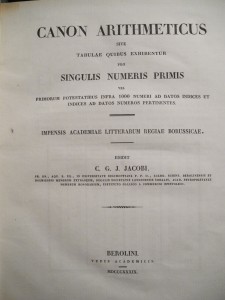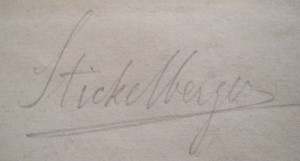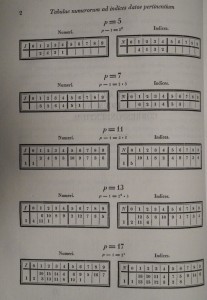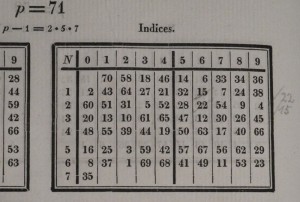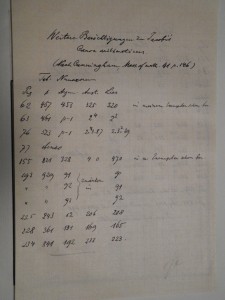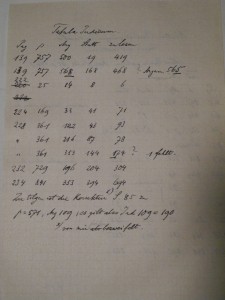“Orismology”, from the Oxford English Dictionary Word Of The Day, is the right term for the discussion of technical terminology (the théorie des termes de métier, as we say in French).
Category: Mathematics
Stickelberger’s copy of Jacobi’s “Canon arithmeticus”
I am currently the head of the Mathematics Library at ETH (which is separate from the main library). A few days ago, I surveyed some of the (relatively) old books in our collection with one of the librarians, just to see if some of these should be handled in a special way. We didn’t find anything really out of the ordinary (no copy of Poincaré’s works heavily annotated by H. Weyl, I’m afraid), but one book has some historical interest: it is (or seems to be) Stickelberger’s copy of Jacobi’s “Canon arithmeticus”
a table of primitive roots and discrete logarithms for primes up to 1000.
Stickelberger’s signature is found on one of the first pages
The table itself, as it took me a few minutes to understand (my Latin being non-existent), lists for each prime the “Numeri”
and the “Index”
, which are defined by the relation
for some primitive root modulo
, which can be identified easily by looking for the number for which
is equal to
:
So above we see that Jacobi selected as primitive root modulo
and
, and
as primitive root modulo
, or
as primitive root modulo
. Obligingly, he also indicates the factorization of
(so that all primitive roots can be easily found by checking whether the corresponding index is coprime with
).
Like the copy which was digitized by Google, Stickelberger’s has a list of corrections at the end, and most (if not all: I didn’t check…) of these are incorporated in pencil in the main text, as here with :
However, Stickelberger (if it was him) also had another list of corrections, written down on a separate loose sheet of paper inserted at the end of the book.
These corrections are reproduced from the paper On quasi-mersennian numbers by Lieutenant Colonel Allan Cunningham in Vol. 41 of the Messenger of Mathematics (a volume which seems famous in statistical circles because it contains, ten pages later, an important paper of R.A. Fisher on maximum likelihood…) But even Cunningham’s corrections contain a few mistakes, which Stickelberger reports (though with question marks):
Indeed, for , the primitive root chosen by Jacobi is
and we have
instead of reported by Cunningham (and
in the Canon).
As far as I could see during my quick inspection, there are no further annotations or comments by Stickelberger, nor any date indicating when he acquired this book. The publication date is 1839, and the only other indication is that the volume of the Messenger of Mathematics with Cunningham’s paper appeared in 1912. I also do not known when and how the book entered the collection of ETH.
A cruel dilemma
From a recent article in the New York Times:
“On the satellite channels, I watch ‘America’s Got Talent’ dubbed in Persian, while at the same time, our state television is showing an hourlong program on mathematics. Which one would you prefer?” asked ************, 30, an insurance salesman.
Upcoming events!
There will be quite a few number-theoretic activities that I will be involved-in this year. In chronological order:
(1) In March, on Friday the 15th and Saturday the 16th, there will first be the 10th edition of the ETH-EPFL Number Theory Days, this time in Lausanne. The web page is currently not very informative (except for links to the previous editions…), but the speakers this year will be L. Berger (ENS Lyon), E. Lindenstrauss (Hebrew University), H. Oh (Brown University), N. Templier (Princeton University) and J. Wolf (École Polytechnique). This is organized by Ph. Michel and myself.
(2) Immediately following, there will be a conference on “Equidistribution in number theory and dynamics” at the Forschungsinstitut für Mathematik of ETH, organized jointly by M. Einsiedler, E. Lindenstrauss, Ph. Michel and myself, from March 18 to 22. There is a web page with the current list of speakers. We would especially like to invite young mathematicians to apply here for financial support if they wish to attend this conference (the deadline indicated is January 15th, but a few more days should not hurt).
(3) During the first week of June, again at FIM, G. Wustholz and myself are organizing a conference to celebrate the 25th anniversary of the Number Theory Seminar at ETH. Additional details will appear soon….
(4) Finally, from June 17 to 21, in sunny Marseille, R. de la Bretèche, Ph. Michel, J. Rivat and myself are co-organizing a conference on Analytic Number Theory in honor of É. Fouvry’s 60th birthday. This will be held at CIRM, which is a also a very nice place indeed to do mathematics. The web page for the conference is here; registration to the conference should be done on the CIRM website (the registration form is not there yet).
Three new papers
In this post, I will just describe briefly three papers (one long, two short) that É. Fouvry, Ph. Michel and myself have finished in recent weeks and days concerning the properties of trace functions. The last one should be on arXiv tomorrow, the others are there already. I will probably say more about some (or all) of these papers later, but here are quick summaries of what we do…
(1) “Counting sheaves with spherical codes”
This is a fairly short note, where we use the quasi-orthogonality of trace functions (in the geometrically irreducible case), which encapsulates Deligne’s general form of the Riemann Hypothesis over finite fields, in order to derive upper-bounds for the number of such functions with bounded conductor over a given finite field. As it turns out, the same quasi-orthogonality implies that we do something more geometrically interesting: for “small enough” conductor, the trace function essentially determines the sheaf, and so we are counting sheaves.
In spirit, this is therefore close to many counting problems of number theory: we have a countable set, a measure of complexity which allows us to write it as an increasing union of finite sets, and we want to know how many elements there are in these finite subsets.
A difference with many more classical problems, however, is that it seems rather difficult to get asymptotics when counting trace functions. If we use a Langlands correspondance, we are trying to count automorphic representations on with some bounds on ramification. We realized only rather late the existence of very striking conjectures and results of Drinfeld and Deligne (among others; see this excellent account of Deligne’s work by Esnault and Kerz) for the precise counting in the vertical direction (fixing a base field, and extending it), which should — under suitable conditions — take a form very similar to a Lefschetz Trace Formula. Our bounds do not really contribute to this question, since they are (probably far off) upper-bounds only, but they are completely explicit and they work in the “horizontal” direction (bounding the conductor and letting
go to infinity.)
As to the spherical codes of the title, they arise because the quasi-orthogonality shows that, as vectors in the -dimensional real vector space of complex-valued functions on
, the (normalized) trace functions with conductor
have a strong angular-separation property, and subsets of unit spheres with this property are precisely called “spherical codes”. The question of giving upper-bounds for the cardinality of spherical codes with given angular separation is quite important, but interestingly we did not find the range given by the Riemann Hypothesis in the literature (this has the effect of making the cardinality grow polynomially as a function of
for a fixed bound on the conductor; a polynomial growth is the right answer for our problem, though finding the right exponent is a rather delicate question). We tweaked the ideas of Kabatjanski and Levenshtein (who have the best-known results in general) for our purpose, which involves some fun estimates depending on the location of the first zero of the Airy function…
(2) “An inverse theorem for Gowers norm of trace functions over prime fields”
This is again a fairly short paper, which does pretty much what the title suggests: for a trace function over
, and an integer
, we find an estimate for the
-th Gowers norm
of
(see Section 3 of this part of T. Tao’s notes on higher-order Fourier analysis for an introduction to these norms). This takes the form
where the implied constant depends only (completely explicitly) on the conductor of and on
, except (this is the inverse part in the title) when the sheaf
which gives rise to
contains at least one Jordan-Hölder factor with trace function of the type
for some polynomial of degree
. These functions are the natural obstructions to having small Gowers norms (as already emphasized by Gowers), but one doesn’t usually get to have such strong structural statements as those we get: if
is geometrically irreducible, then the only possibility is that it is exactly proportional to a function of the type above (for all
).
None of the three of us can be said to be a great expert on the Gowers norms (which have been studied much more deeply by others, most spectacularly by Gowers and recently by Green, Tao and Ziegler), and this note is basically our attempt at seeing if the (fairly algebraic) definition could be studied using the sheaf formalism and the Riemann Hypothesis. But the final estimate is interesting in that, as far as the dependency on is concerned, it is the same as one would get for a “random” function (in the model where we consider a function
modulo
such that the
are independent uniformly bounded random variables with mean zero; we found this statement in the book of Tao and Vu), and it seems that no “deterministic” examples of such functions had been written down before. From our result, one can see for instance that
for any fixed non-constant polynomial ,
being the Legendre character modulo
, with the implied constant depending only on
and
(again, completely explicitly).
(3) “Algebraic trace functions over the primes”
The longest and deepest of our three papers continues the study of orthogonality of trace functions against other natural arithmetic sequences. After dealing with Fourier coefficients of modular forms in the first paper, we consider sums over primes, and sums against the Möbius function. Precisely, let be a trace function modulo
. Say that
is
-exceptional if it is proportional to
for some Dirichlet character modulo
and some
(allowing trivial
and/or
.) Then, if
is not
-exceptional we have
for any , where the implied constant depends only on the conductor of
and on
. The “critical” case is when
or is a bit smaller, in which case we therefore get cancellation with a power saving. It is well-known that one expects such a bound for a
-exceptional
also, but that this is essentially equivalent to proving the existence of a zero-free strip for some Dirichlet
-function, so that the restriction is natural in the current state of knowledge.
Similarly, we have
with the same conditions.
These estimates are rather sweeping: we can take any of the examples of trace functions explained in the previous post (making sure they are not exceptional, but for instance any irreducible sheaf of rank at least is not exceptional, as is any rank
sheaf with a singularity not at
or
…). Although some specializations to specific trace functions had been already studied (sometimes with stronger exponents), we find the generality to be a really remarkable example of the power of the structural features coming from Deligne’s work. and from the formalism of algebraic geometry, which we use again extensively. Indeed, we need not only all the work of the previous paper on twists of Fourier coefficients of modular forms (applied to Eisenstein series), but we also had to establish some additional sheaf-theoretic properties.
To give an example, we get immediately that if is a Dirichlet character of order
, and
is a polynomial which is not proportional to an
-th power times a monomial (e.g., if
is squarefree) we have
where the implied constant depends only on and on
. As far as we know, the only case previously treated (going back to Karatsuba) is when
, with
, is linear…
Among a number of applications, which can be found in the paper (and before we find others…), the following is also fairly nice: given squarefree and non-constant, we have
where denotes in general the error term in the prime number theorem in arithmetic progressions
and the implied constant depends only on and on
. In fact, with a whiff of extra formalism, we can replace the sum over residue classes of the form
taken with the multiplicity of representation to the corresponding sum over the the residues of this form, without multiplicity.
